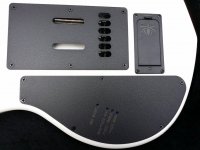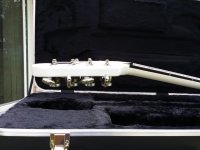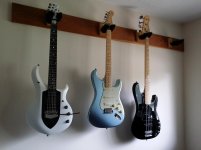Greg Suarez
Well-known member
If you are ignoring this guitar because you don't like what it looks like, I have two things to say to you: 1) get over yourself because you're missing out on the sleekest guitar ever made, and 2) more for those of us who "get" this guitar.
After I opened the shipping box and slid the case out, I picked up the plastic TSA-style case (proudly sporting a "Music Man Majesty" badge) and was shocked by how lightweight the package was. I honestly thought the guitar was not in the case. I was relieved to discover the guitar was in there, it's just light. Really light. Really, really, really light - almost like it's made of plastic. And it's slick and it's relatively slender. The design of the Majesty makes you think this inanimate object is ready to jump out of your hands and jet away at light speed. As John Petrucci has mentioned in interviews, the Majesty (nee Stallion) was inspired by German sports cars. Mission accomplished. The Majesty truly is the sports car of guitars. It is the perfect mid-life crises purchase to go with a brand new cherry red BMW 6 Series.
The neck is extremely fast and the neck-through design gives you easy access to the 24th fret unlike any guitar I've ever played. The control knobs feel a bit beefier than the average JP6/7 knob, and the push/push controls feel incredibly smooth and effortless. I much prefer these over push/pull, as knob grip can sometimes be hit-and-miss with the pulls (especially on Gibsons, in my experience). The pickup and piezo switches are notably smaller than past JP models, and will take a little getting used to for seasoned JP players. One awesome new touch is that the fretboard inlays (set into a gorgeous, dark ebony board) are mirrored, including the Majesty/Dream Theater logo at the first fret.
Before plugging in an electric guitar, I always play it acoustically for a while. This, more than anything else, will tell you if the guitar will sound good plugged in. Unplugged, the Majesty is bold, bright and aggressive. It even has a very subtle "growling" overtone I've never heard in an unplugged electric guitar ("growling" is not quite right, but it's the closest word I can come up with).
Plugged in, the Majesty roars. It's a gorgeous, dramatic and authoritative sound that pours out of the DiMarzio Illuminator pickups. My primary experience with the JP models is with a standard basswood JP6 with the Crunch Lab/LiquiFire combo. Compared with that tried and true combination, the Majesty is the equivalent of a trusty caterpillar that has blossomed into a majestic (natch) butterfly. A butterfly with teeth. The Majesty presents like a JP6 that has been supercharged and had a thin veneer of compression removed from its sound. The Illuminator duo, coupled with the maple cap, mahogany neck-through and ebony board (no cap, maple neck and rosewood on standard JP6s), produce a sound that is tighter than the previous DiMazio pair, but at the same time more open and expressive. The piezo system remains unchanged, but receives the similar benefits of the new wood combination as the magnetic pickups. Also of note is the dual 1/4" output of past JPs has been pared down to a single output. The use of either a mono or TRS cable dictates how differently the piezo system operates. Some will hate this because they prefer to use a different amp for each output, but I applaud this move as I personally never use two amps simultaneously. Simpler is better for me.
One of the most striking and audible differences between the classic JPs and the Majesty is the Majesty takes the JP's already impressive levels of sustain to a completely different plane of existence. Kicking into a creamy lead channel is exactly where the Illuminator neck pickup is most at home. It grabs hold of the strings' vibrations and refuses to let go until the last bit of tone has been squeezed out of the note's very life. The guitar sings and sustains unlike any guitar you have played before.
There are only a couple of things about the Majesty I don't like, and they're both cosmetic. The first is the color options. They are all pearlescent colors inspired by sports cars. Normally I like these colors. But for some reason, I don't really like them on this guitar. I chose the Glacial Frost/white because I do like the contrast of the bright body against the dark fretboard. If you look at the fifth picture I posted, you can really see the pearl characteristic of the finish in the sun reflection on the neck.
My second complaint is the faux carbon fiber maple shield design on the body. The color gradation of the etching muddles the aesthetics slightly. If it were real carbon fiber it would look far better, but probably sound terrible. This etching is probably why I don't care for the body colors. The brownish gradation of the etching disturbs the boldness and authority of the colors. If MM could somehow find a way to make that carbon fiber a consistent, darker color, I think that would solve my problem with it.
Ultimately, color and aesthetic choices aside, the Music Man Majesty is one of the most amazing new designs to shake the foundations of a guitar market that has grown stagnant on slight variations of age-old Fender and Gibson designs. The Majesty is a bold and ballsy guitar that very few manufactures would have the guts to release. It is a futuristic guitar for creative players interested in evolved design philosophies and taking their chops to the next level. The absolute best compliment I can give the Majesty is I can't wait to get another one. The next guitar I buy will be a 7-string Majesty, likely in the Iced Crimson finish. But this kind of money is not easy for me to get, so by the time I'm ready for a new one, I hope the color options have been extended.
If you snub this guitar simply because of what it looks like, you are doing yourself a terrible disservice.
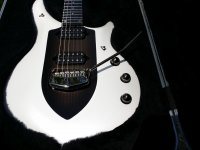
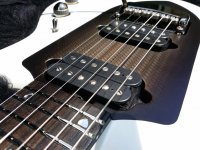
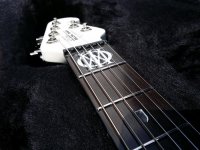
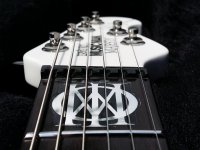
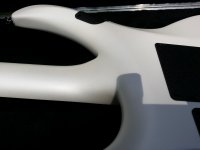
After I opened the shipping box and slid the case out, I picked up the plastic TSA-style case (proudly sporting a "Music Man Majesty" badge) and was shocked by how lightweight the package was. I honestly thought the guitar was not in the case. I was relieved to discover the guitar was in there, it's just light. Really light. Really, really, really light - almost like it's made of plastic. And it's slick and it's relatively slender. The design of the Majesty makes you think this inanimate object is ready to jump out of your hands and jet away at light speed. As John Petrucci has mentioned in interviews, the Majesty (nee Stallion) was inspired by German sports cars. Mission accomplished. The Majesty truly is the sports car of guitars. It is the perfect mid-life crises purchase to go with a brand new cherry red BMW 6 Series.
The neck is extremely fast and the neck-through design gives you easy access to the 24th fret unlike any guitar I've ever played. The control knobs feel a bit beefier than the average JP6/7 knob, and the push/push controls feel incredibly smooth and effortless. I much prefer these over push/pull, as knob grip can sometimes be hit-and-miss with the pulls (especially on Gibsons, in my experience). The pickup and piezo switches are notably smaller than past JP models, and will take a little getting used to for seasoned JP players. One awesome new touch is that the fretboard inlays (set into a gorgeous, dark ebony board) are mirrored, including the Majesty/Dream Theater logo at the first fret.
Before plugging in an electric guitar, I always play it acoustically for a while. This, more than anything else, will tell you if the guitar will sound good plugged in. Unplugged, the Majesty is bold, bright and aggressive. It even has a very subtle "growling" overtone I've never heard in an unplugged electric guitar ("growling" is not quite right, but it's the closest word I can come up with).
Plugged in, the Majesty roars. It's a gorgeous, dramatic and authoritative sound that pours out of the DiMarzio Illuminator pickups. My primary experience with the JP models is with a standard basswood JP6 with the Crunch Lab/LiquiFire combo. Compared with that tried and true combination, the Majesty is the equivalent of a trusty caterpillar that has blossomed into a majestic (natch) butterfly. A butterfly with teeth. The Majesty presents like a JP6 that has been supercharged and had a thin veneer of compression removed from its sound. The Illuminator duo, coupled with the maple cap, mahogany neck-through and ebony board (no cap, maple neck and rosewood on standard JP6s), produce a sound that is tighter than the previous DiMazio pair, but at the same time more open and expressive. The piezo system remains unchanged, but receives the similar benefits of the new wood combination as the magnetic pickups. Also of note is the dual 1/4" output of past JPs has been pared down to a single output. The use of either a mono or TRS cable dictates how differently the piezo system operates. Some will hate this because they prefer to use a different amp for each output, but I applaud this move as I personally never use two amps simultaneously. Simpler is better for me.
One of the most striking and audible differences between the classic JPs and the Majesty is the Majesty takes the JP's already impressive levels of sustain to a completely different plane of existence. Kicking into a creamy lead channel is exactly where the Illuminator neck pickup is most at home. It grabs hold of the strings' vibrations and refuses to let go until the last bit of tone has been squeezed out of the note's very life. The guitar sings and sustains unlike any guitar you have played before.
There are only a couple of things about the Majesty I don't like, and they're both cosmetic. The first is the color options. They are all pearlescent colors inspired by sports cars. Normally I like these colors. But for some reason, I don't really like them on this guitar. I chose the Glacial Frost/white because I do like the contrast of the bright body against the dark fretboard. If you look at the fifth picture I posted, you can really see the pearl characteristic of the finish in the sun reflection on the neck.
My second complaint is the faux carbon fiber maple shield design on the body. The color gradation of the etching muddles the aesthetics slightly. If it were real carbon fiber it would look far better, but probably sound terrible. This etching is probably why I don't care for the body colors. The brownish gradation of the etching disturbs the boldness and authority of the colors. If MM could somehow find a way to make that carbon fiber a consistent, darker color, I think that would solve my problem with it.
Ultimately, color and aesthetic choices aside, the Music Man Majesty is one of the most amazing new designs to shake the foundations of a guitar market that has grown stagnant on slight variations of age-old Fender and Gibson designs. The Majesty is a bold and ballsy guitar that very few manufactures would have the guts to release. It is a futuristic guitar for creative players interested in evolved design philosophies and taking their chops to the next level. The absolute best compliment I can give the Majesty is I can't wait to get another one. The next guitar I buy will be a 7-string Majesty, likely in the Iced Crimson finish. But this kind of money is not easy for me to get, so by the time I'm ready for a new one, I hope the color options have been extended.
If you snub this guitar simply because of what it looks like, you are doing yourself a terrible disservice.





Last edited:


